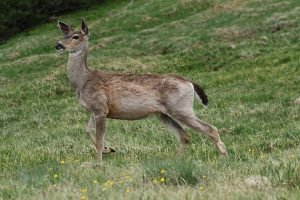Black-tailed Deer
Black-tailed deer are a member of the mule deer family and found across the Pacific Northwest of North America.
Scientific Classification
| Kingdom | Animalia |
| Phylum | Chordata |
| Class | Mammalia |
| Order | Artiodactyla |
| Family | Cervidae |
| Subfamily | Capreolinae |
| Genus | Odocoileus |
| Species | O. hemionus |
| Scientific Name | Odocoileus hemionus columbianus |
Quick Information
| Also known as | Blacktail deer, Columbian black-tailed deer |
| Description | Weight: Adult males, called bucks, weigh around 200 lbs (91 kg), while does, adult females, weigh around 130 lbs (59 kg) Color: Their pelage ranges from reddish to brown, light or dark ash-gray, to even a dark brownish gray Size: Large males stand up to 3 ft (1 m) at the shoulder |
| Distribution | Common in the states of California, western Oregon, Washington, near the coasts and interiors of British Columbia and northwards near Alaska |
| Habitat | Forest edges with sufficient shelter and abundant meadows |
| Sounds & Communication | Through touch, vision, sounds; they also communicate through scent and pheromones secreted from glands on the lower part of their legs; does use bleats to communicate with each other |
| Lifespan | 9-10 years in the wild; 17-20 years in captivity |
| Diet | Douglas fir, red huckleberry, western red cedar, deer fern, salal, and lichen during the winter; grass, apples, firewood, forbs, salmonberry, and maple during the spring |
| Adaptations | The ears are large and can move independently, giving them an excellent sense of hearing; males have a good sight as well and can see other animals at a distance of up to 2,000 ft (600 m) |
| Predators | Coyotes, pumas, and domestic dogs |
| IUCN Conservation Status | Least Concern |
Behavior
Black-tailed deer are active at dusk and dawn. During the day they rest in thickets near streams of water. They migrate from higher altitudes where they spend the summer to lower elevations during the winter. These ungulates are browsers and can be seen browsing around forests on the roadside.
Mating & Reproduction
The mating season, also called the rutting season takes place during November and December during which time bucks chase after does, sometimes back and forth across roads. The gestation period lasts between 6 and 7 months after which the doe usually gives birth to two fawns, although three babies have also been seen. Younger does usually give birth to only one fawn.
Life-cycle
Fawns are born with a weight of around 6-8.8 lb (2.7-4 kg). They are left alone by themselves while the mother goes off to browse, as she has to feed sufficiently to produce enough milk for the fawns. Females reach sexual maturity at around 16 months old while males attain gusto at 16½ months of age.
Interesting Facts
- There is a considerable argument among scientists regarding whether to consider the black-tailed deer a species on its own, or whether to keep it as a subspecies of the mule deer.
- The black-tailed deer is a popular game animal for hunters.
- They shed their antlers between January and March, but these grow back between April and August.
References:
- https://gunnersden.com/father-and-daughter-mistaken-as-deer-killed-on-hunting-trip/
- http://www.westernhunter.com/Pages/Vol02Issue24/blacktail.html
- https://www.iucnredlist.org/species/42393/22162113
- https://www.nps.gov/olym/learn/nature/black-tail-deer.htm
- https://www.inaturalist.org/taxa/42221-Odocoileus-hemionus-columbianus
- https://animalia.bio/black-tailed-deer
- https://animals.mom.com/blacktailed-deer-6477.html
Published on August 5th 2017 by Sudipto Chakrabarti under Coniferous Forest Animals.
Article was last reviewed on 5th December 2024.









